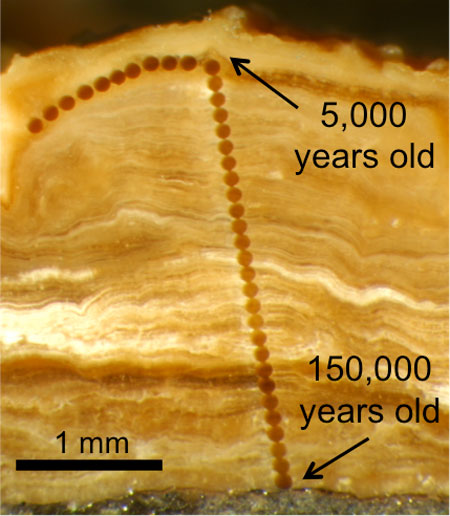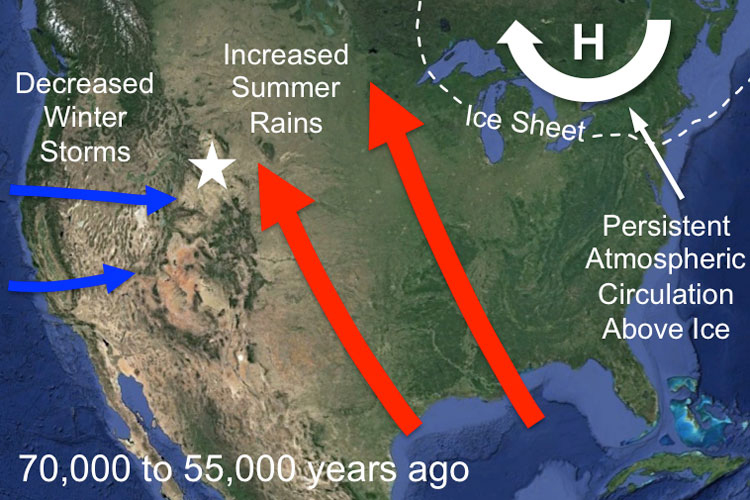Growth rings on rocks give up North American climate secrets
Scientists have found a new way to tease out signals about Earth’s climatic past from soil deposits on gravel and pebbles, adding an unprecedented level of detail to the existing paleoclimate record and revealing a time in North America’s past when summers were wetter than normal.

A research team led by UC Berkeley soil scientists obtained data about precipitation and temperature in North America spanning the past 120,000 years, which covers glacial and interglacial periods during the Pleistocene Epoch. They did this at thousand-year resolutions — a blink of an eye in geologic terms — through a microanalysis of the carbonate deposits that formed growth rings around rocks, some measuring just 3 millimeters thick.
“The cool thing that this study reveals is that within soil — an unlikely reservoir given how ‘messy’ most people think it is — there is a mineral that accumulates steadily and creates some of the most detailed information to date on the Earth’s past climates,” said senior author Ronald Amundson, a UC Berkeley professor of environmental science, policy and management.
The study, published today in the Proceedings of the National Academy of Sciences, shows the rich potential held within soil deposits known as pedothems, which form growth rings on rocks. The samples used in the study came from Wyoming’s Wind River Basin.
Because these soil deposits are commonly found in drylands all over the world, they can provide a rich source of data for paleoclimatologists, the authors said.
“We can now begin to develop records of how local and regional climate boundaries have shifted through time and in response to worldwide warming or cooling,” said study lead author Erik Oerter, who conducted the research as part of his UC Berkeley Ph.D. dissertation.
120,000 years of history in 3 millimeters of rock
Pedothems are a powerful complement to existing geological records of past climate, including ice cores, lake and ocean sediments, and stalactites and stalagmites in caves. They have the advantage of being fairly ubiquitous in regions now populated by humans, unlike the polar regions where ice cores are often obtained.
Key advances in the ability to precisely analyze micro-samples of soil deposits enabled researchers to extract telltale signs of climate change.
“By using micro-analytical measurements on spots as small as 0.01 millimeters in diameter, we can develop time series of past climate conditions in a way that no one has done before,” said Oerter. “It is evident that the carbonate coatings formed in concentric bands around the rocks, much like the annual growth rings in a tree, except that these laminations form over timescales of several hundred years.”

The researchers used laser ablation and an ion microprobe, much like a tiny dental drill, to obtain microscopic samples for analysis. Uranium isotopes were used to date the deposits, while oxygen and carbon isotopes revealed clues about the precipitation, temperature and soil respiration at the time the mineral was formed.
For instance, warmer rain from the Gulf of Mexico resulted in higher levels of oxygen 18 compared with the cold precipitation from snowstorms blowing eastward across the Rockies. The ratio of carbon 13 and carbon 12 isotopes reflected levels of soil respiration, which is a proxy for plant productivity.
Uranium isotopes were used for dating the sample, but they were also used to calculate how much rain the soil receives, serving as a type of “paleo rain gauge,” said Oerter, who is now a postdoctoral researcher at the University of Utah.
Finding what other records couldn’t
The new data revealed that 70,000 to 55,000 years ago, in the midst of a minor ice age, the pattern of precipitation in North America shifted from one dominated by a west-to-east flow of storms from the north Pacific to a south-to-north flow from the Gulf of Mexico. The researchers attributed that to a stable, high-pressure system that parked itself over massive ice sheets that covered eastern Canada and northeastern United States, which helped bring up more air from the south.
That atmospheric circulation translated into wetter summers and drier winters in central North America, a reverse of the usual pattern in which more precipitation falls in the winter.
“This is a new insight from geologic sources of paleoclimate data,” said Oerter. “The techniques that we developed can now be applied to similar soil deposits to fill in key gaps in the paleoclimate record. The information will be useful to improve the accuracy of climate models by providing known conditions to calibrate them to.”
Other study co-authors include researchers from the Berkeley Geochronology Center, University of Melbourne, University of Wisconsin, Vanderbilt University and Wisconsin Lutheran College.
The National Science Foundation helped support this work.
See also:
